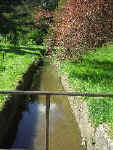|
Ecological Surveys
Peter Brett
Associates, 2001
The first of three
ecological surveys was carried out by
Peter Brett Associates in 2001, as part of a feasibility study
for the Coy Pond Gardens project. It covered the entire length of
the gardens from the railway embankment to Branksome Wood Road.
The survey included the sampling of
aquatic invertebrates in order to assess the overall water quality.
Macro-invertebrates were limited in both numbers and diversity.
A water beetle, several families of
molluscs, midge larvae, water hoglouse and several mayfly larvae
were found by the plant sampling. Gravel sampling revealed cased
caddis-fly larvae, a mayfly larvae and several water shrimps.
The results indicated a poor to fair
grading with the indicator species dominated by pollution tolerant
organisms. A copy of the report is
available on request.
Economics eventually
dictated the extent of the final works which focused on the upper
section of gardens where poor quality water discharges from the
culvert.
Aquilina Environmental Quality
Consultant, 2003
A second 'baseline'
ecological survey was commissioned to cover the immediate working
area - it was followed up two years later in order to gauge the
impact of the works [more].
The Biological
Monitoring Working Party (BMWP)
scoring system is used to evaluate the stream and assign a
quality category to it.

The 2003 survey
was carried out on 26th August. It covered freshwater
life in the stream, and a plant survey of the surrounding banks and
field which were due to be affected by the works.
Summary
This baseline
survey shows a section of stream with little variety and plenty of
opportunities to increase habitat diversity. The vegetation survey
shows a field of little botanical interest.
The results of
the freshwater survey show a rather restricted range of
invertebrates compared with other reaches of the Bourne Stream. The
BMWP scores reflect the sensitivity of invertebrates (at Family
level) to organic pollution, thus the presence of species with
scores of up to 8 (the most sensitive species score 10) show that
the stream is not unduly affected by pollution or organic
enrichment.
The total BMWP
score for the site is 76 which suggests a moderately clean site
(values greater than 100 are associated with clean rivers and values
less than 10 with heavily polluted waters).
The reasons for
the paucity of species are likely to be threefold:
|
1. |
Vertical,
mostly concrete, embankments offer little in the way of
shoreline for invertebrates or plants, thus habitat diversity
is restricted. |
|
2. |
Lack of
submerged or emergent vegetation will severely restrict
habitats for invertebrates. There are only small patches of
Curled Pondweed (Potamogeton crispus), Water Plantain (Alisma
plantago-aquatica) and Floating Clubrush (Eleogiton
fluitans) actually submerged and small patches of
overhanging Creeping Bent (Agrostis stolonifera) and
Hemlock Water Dropwart (Oenanthe crocata). |
|
3. |
The
quality of the water emerging from the culvert. As this has
been underground for some distance, there will have been no
primary production and therefore will be low on food content.
It also shows a red-brown deposit of iron oxides which coat
the bottom and any submerged plants, thus restricting the
ability of plants to grow at this point in the stream. |
The proposed
works will address the first issue directly and as a consequence
will improve conditions for submerged and emergent vegetation (point
2 above). The siting of the pond should capture the water emerging
from the culvert and filter it through reedbeds which will restrict
the deposit and improve conditions further downstream. The proposed
weir and rock splash pool should also increase the oxygen content of
the water and improve the water quality downstream.
Comparison with
previous data suggests that the stream has improved since 2001 as a
result of works carried out upstream. The potential for biodiversity
in the stream would appear to be limited more by physical and
structural components than chemical or organic pollution. Therefore
the proposed works should improve both the stream and surroundings
by offering an increase in the range of habitats available.
 Aquilina
Environmental Quality Consultant, 2005 Aquilina
Environmental Quality Consultant, 2005
The follow-up
survey was carried out on 11th August 2005 using exactly the same
protocol as for the baseline survey in 2003, and at the same time of
year, so results can reliably be compared.
Summary
Robert Aquilina
recorded a list of 30 macroinvertebrates and a BMWP score of 94
which indicates a good quality site with clean water; a clear
improvement on the previous survey which recorded 20 species and a
BMWP score of 76.
He also surveyed
the vegetation beside the stream, and listed 42 species compared
with 16 two years ago! At least 10 of the new species were
introduced with the planting scheme that was carried out after the
earthworks.
The report confirms
that the restructuring of the stream has been successful in
introducing greater diversity of physical habitats which is
reflected in the increased diversity of both plants and
macroinvertebrates recorded in his survey.
In conclusion
Robert writes:
“The current situation is of a stream with good water quality and
a diverse range of macroinvertebrates and plants”.
The table below
indicates just how far we’ve come in the past four years:
|
Survey date
|
2001
|
2003
|
2005
|
|
BMWP score
|
35
|
76
|
94
|
|
Species richness
|
n/a
|
20
|
30
|
The original
survey in 2001 recorded a poor quality site in terms of wildlife
habitat; in 2005 it is transformed to a good, bordering on very good
quality.
The Partnership
is very proud that the Bourne Pools project already appears to have
met many of its objectives.
|